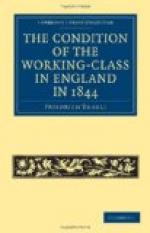places, so that fifteen to twenty persons are packed,
one on top of the other, I cannot say accommodated,
in a single room. These districts shelter
the poorest, most depraved, and worthless members of
the community, and may be regarded as the sources
of those frightful epidemics which, beginning here,
spread desolation over Glasgow.”
Let us hear how J. C. Symonds, Government Commissioner for the investigation of the condition of the hand-weavers, describes these portions of the city: {38}
“I have seen wretchedness in some of its worse phases both here and upon the Continent, but until I visited the wynds of Glasgow I did not believe that so much crime, misery, and disease could exist in any civilised country. In the lower lodging-houses ten, twelve, sometimes twenty persons of both sexes, all ages and various degrees of nakedness, sleep indiscriminately huddled together upon the floor. These dwellings are usually so damp, filthy, and ruinous, that no one could wish to keep his horse in one of them.”
And in another place:
“The wynds of Glasgow contain a fluctuating population of fifteen to thirty thousand human beings. This quarter consists wholly of narrow alleys and square courts, in the middle of every one of which there lies a dung heap. Revolting as was the outward appearance of these courts, I was yet not prepared for the filth and wretchedness within. In some of the sleeping-places which we visited at night (the Superintendent of Police, Captain Miller, and Symonds) we found a complete layer of human beings stretched upon the floor, often fifteen to twenty, some clad, others naked, men and women indiscriminately. Their bed was a litter of mouldy straw, mixed with rags. There was little or no furniture, and the only thing which gave these dens any shimmer of habitableness was a fire upon the hearth. Theft and prostitution form the chief means of subsistence of this population. No one seemed to take the trouble to cleanse this Augean stable, this Pandemonium, this tangle of crime, filth, and pestilence in the centre of the second city of the kingdom. An extended examination of the lowest districts of other cities never revealed anything half so bad, either in intensity of moral and physical infection, nor in comparative density of population. In this quarter most of the houses have been declared by the Court of Guild ruinous and unfit for habitation, but precisely these are the most densely populated, because, according to the law, no rent can be demanded for them.”
The great manufacturing district in the centre of the British Islands, the thickly peopled stretch of West Yorkshire and South Lancashire, with its numerous factory towns, yields nothing to the other great manufacturing centres. The woollen district of the West Riding of Yorkshire is a charming region, a beautiful green hill country, whose elevations grow more rugged towards




